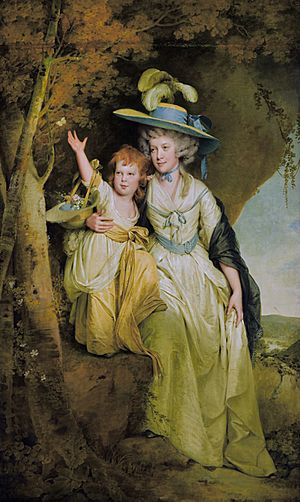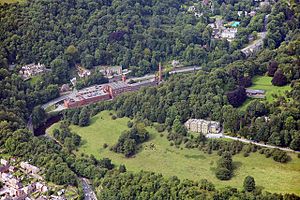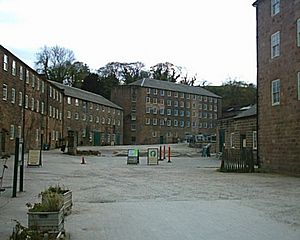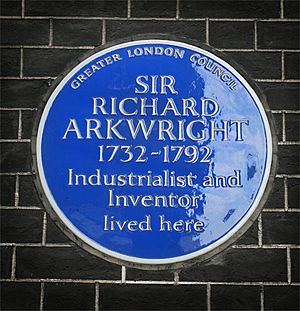Richard Arkwright facts for kids
Quick facts for kids
Richard Arkwright
|
|
|---|---|

Sir Richard Arkwright,
oil on canvas, by Mather Brown, 1790. New Britain Museum of American Art, Connecticut. |
|
| Born | 23 December 1732 Preston, Lancashire, England
|
| Died | 3 August 1792 (aged 59) Cromford, Derbyshire, England
|
| Title | Sir Richard Arkwright |
| Spouse(s) | Patience Holt, Margaret Biggins |
| Children | Richard Arkwright junior, Susannah Arkwright |
| Signature | |
Sir Richard Arkwright (born December 23, 1732 – died August 3, 1792) was an English inventor. He was also a very important businessman during the early Industrial Revolution. He helped create the spinning frame, which was later called the water frame. This machine used water power to spin cotton.
He also invented a machine to prepare raw cotton for spinning. Arkwright was the first person to build factories that did both these steps using machines.
Arkwright's big success was combining power, machines, and workers. He used cotton to make huge amounts of yarn. People called him the "father of the modern industrial factory system." This was because of how he organized his mill in Cromford, Derbyshire. This mill is now part of a World Heritage Site.
Contents
Early Life and Family

Richard Arkwright was born in Preston, England. This was on December 23, 1732. He was the youngest of seven children who lived. His father, Thomas, was a tailor.
Richard's parents could not afford to send him to school. So, his cousin Ellen taught him to read and write. He started working as a barber and wig-maker. He opened his own shop in Bolton in the early 1760s.
Here, he invented a special waterproof dye for wigs. The money he made from this dye later helped him pay for his cotton machines.
Arkwright married Patience Holt in 1755. They had a son, Richard Arkwright Junior, that same year. Patience died in 1756. In 1761, Arkwright married Margaret Biggins. They had three children, but only Susannah lived to be an adult. After his first wife died, Arkwright became very interested in making machines for carding and spinning cotton. These machines would replace hand work.
Arkwright's Amazing Inventions
The Spinning Frame
In 1768, Arkwright worked with John Kay, a clockmaker. They rented rooms in Preston to work on a spinning machine. In 1769, Arkwright received a patent for his spinning frame.
This machine used wooden and metal rollers to make twisted threads. At first, horses powered this machine. It made spinning cotton much cheaper. This invention changed the textile industry a lot.
The Carding Engine
Another inventor, Lewis Paul, had made a carding machine in 1748. Arkwright improved this machine. In 1775, he got a patent for his new carding engine. This machine turned raw cotton into a long, continuous strand.
The machine used rollers that spun at different speeds. This stretched out the cotton. Then, it twisted the cotton into a strong thread. This thread was good enough for the warp threads of cloth.
Building the First Factories
Cromford Mill: A New Way to Work
Arkwright and John Smalley started a small factory in Nottingham. It was powered by horses. To get more money, Arkwright partnered with Jedediah Strutt and Samuel Need. They were rich hosiery makers.
In 1771, these partners built the world's first water-powered mill. This was at Cromford. It did both carding and spinning. About 200 people worked there.
In 1776, Arkwright built a second, bigger mill at Cromford. He also built mills in other places like Bakewell and Wirksworth. His success as a businessman was clear. The spinning frame was a big improvement over the Spinning Jenny. Arkwright's machine needed very little training to use. It made strong yarn perfect for weaving.
The Factory System

As the Cromford mill grew, Arkwright needed more workers. So, he brought people from other areas. He built small houses near the mill for them to live in. He also built a pub called the Greyhound. These homes are thought to be the first factory housing ever built.
Arkwright created new, strict rules for working at Cromford. Work was split into two 13-hour shifts each day. Bells rang at 5 AM and 5 PM. The gates closed exactly at 6 AM and 6 PM. Anyone who was late could not work that day and lost extra pay.
Arkwright wanted weavers with big families to move to Cromford. Whole families worked there, including many children. Some children were as young as seven years old. Later, the minimum age was raised to ten. Towards the end of his time, almost two-thirds of his 1,150 workers were children. He gave workers one week of holiday a year. But they could not travel outside the town.
After Cromford, Arkwright leased the Birkacre mill in Chorley. This helped Chorley become an important industrial town. In 1777, he leased Haarlem Mill in Wirksworth. There, he put in the first steam engine used in a cotton mill. This engine helped fill the millpond that powered the mill's waterwheel.
He also helped David Dale set up cotton mills in New Lanark, Scotland. Sadly, a large mill of Arkwright's in Lancashire was destroyed in riots in 1779. These riots were against machines.
Later Life and Legacy
Arkwright was a determined person. He bought out all his business partners. He went on to build more factories in places like Manchester and Matlock Bath. He was a member of the Church of England.
Arkwright became a very important person. He was knighted in 1786, becoming "Sir Richard Arkwright."
He also started building Willersley Castle in 1791. After a fire in 1792, it was rebuilt. His son, Richard Arkwright junior, lived there from 1796. Richard Arkwright died at Rock House, Cromford, on August 3, 1792. He was 59 years old. He left a huge fortune. He was buried at St Giles' Church, Matlock. Later, his body was moved to the family chapel near the castle. This is now St Mary's Church, Cromford.
Remembering Richard Arkwright
- Richard Arkwright's barber shop in Bolton was torn down in the early 1900s. A small plaque on the new building marks where his shop used to be.
- A Greater London Council blue plaque in London remembers Arkwright. It was put up in 1984.
- Arkwright lived in Rock House in Cromford, across from his first mill. In 1788, he bought land to build Willersley Castle. But after it was finished, it burned down. He died before it was rebuilt and never lived in it.
- The Arkwright Society works to restore the Cromford Mill complex. Historic England calls this site "one of the country’s 100 irreplaceable sites." It is also a UNESCO World Heritage Site.
- The Arkwright Scholarships Trust was started in the UK in 1991. It gives scholarships to young people who want to become engineers. By 2014, the Trust was giving about 400 scholarships each year.
Images for kids
See also
 In Spanish: Richard Arkwright para niños
In Spanish: Richard Arkwright para niños




